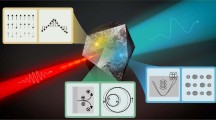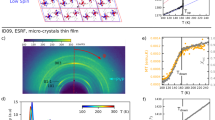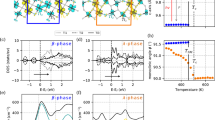Abstract
The extreme electro-optical contrast between crystalline and amorphous states in phase-change materials is routinely exploited in optical data storage1 and future applications include universal memories2, flexible displays3, reconfigurable optical circuits4,5, and logic devices6. Optical contrast is believed to arise owing to a change in crystallinity. Here we show that the connection between optical properties and structure can be broken. Using a combination of single-shot femtosecond electron diffraction and optical spectroscopy, we simultaneously follow the lattice dynamics and dielectric function in the phase-change material Ge2Sb2Te5 during an irreversible state transformation. The dielectric function changes by 30% within 100 fs owing to a rapid depletion of electrons from resonantly bonded states. This occurs without perturbing the crystallinity of the lattice, which heats with a 2-ps time constant. The optical changes are an order of magnitude larger than those achievable with silicon and present new routes to manipulate light on an ultrafast timescale without structural changes.
This is a preview of subscription content, access via your institution
Access options
Subscribe to this journal
Receive 12 print issues and online access
$259.00 per year
only $21.58 per issue
Buy this article
- Purchase on Springer Link
- Instant access to full article PDF
Prices may be subject to local taxes which are calculated during checkout




Similar content being viewed by others
References
Wuttig, M. & Yamada, N. Phase-change materials for rewriteable data storage. Nature Mater. 6, 824–832 (2007).
Wuttig, M. Phase-change materials: Towards a universal memory? Nature Mater. 4, 265–266 (2005).
Hosseini, P., Wright, C. D. & Bhaskaran, H. An optoelectronic framework enabled by low-dimensional phase-change films. Nature 511, 206–211 (2014).
Rudè, M. et al. Optical switching at 1.55 μm in silicon racetrack resonators using phase change materials. Appl. Phys. Lett. 103, 141119 (2013).
Rios, C., Hosseini, P., Wright, C. D., Bhaskaran, H. & Pernice, W. H. P. On-chip photonic memory elements employing phase-change materials. Adv. Mater. 26, 1372–1377 (2014).
Loke, D. et al. Ultrafast phase-change logic device driven by melting processes. Proc. Natl Acad. Sci. USA 111, 13272–13277 (2014).
Loke, D. et al. Breaking the speed limits of phase-change memory. Science 336, 1566–1569 (2012).
Kolobov, A. V. et al. Liquid Ge2Sb2Te5 studied by extended X-ray absorption. Appl. Phys. Lett. 95, 241902 (2009).
Kohara, S. et al. Structural basis for the fast phase change of Ge2Sb2Te5: Ring statistics analogy between the crystal and amorphous states. Appl. Phys. Lett. 89, 201910 (2006).
Kolobov, A. V. et al. Understanding the phase-change mechanism of rewritable optical media. Nature Mater. 3, 703–708 (2004).
Lang, C., Song, S., Manh, D. & Cockayne, D. Building blocks of amorphous Ge2Sb2Te5 . Phys. Rev. B 76, 054101 (2007).
Shportko, K. et al. Resonant bonding in crystalline phase-change materials. Nature Mater. 7, 653–658 (2008).
Huang, B. & Robertson, J. Bonding origin of optical contrast in phase-change memory materials. Phys. Rev. B 81, 081204 (2010).
Lucovsky, G. & White, R. Effects of resonance bonding on the properties of crystalline and amorphous semiconductors. Phys. Rev. B 8, 660–667 (1973).
Caravati, S., Bernasconi, M. & Parrinello, M. First principles study of the optical contrast in phase change materials. J. Phys. Condens. Matter 22, 315801 (2010).
Kolobov, A. V., Krbal, M., Fons, P., Tominaga, J. & Uruga, T. Distortion-triggered loss of long-range order in solids with bonding energy hierarchy. Nature Chem. 3, 311–316 (2011).
Waldecker, L., Bertoni, R. & Ernstorfer, R. Compact femtosecond electron diffractometer with 100 keV electron bunches approaching the single-electron pulse duration limit. J. Appl. Phys. 117, 044903 (2015).
Huang, L., Callan, J., Glezer, E. & Mazur, E. GaAs under intense ultrafast excitation: Response of the dielectric function. Phys. Rev. Lett. 80, 185–188 (1998).
Zeiger, H. et al. Theory for displacive excitation of coherent phonons. Phys. Rev. B 45, 768–778 (1992).
Caravati, S., Bernasconi, M., Kühne, T. D., Krack, M. & Parrinello, M. First principles study of crystalline and amorphous Ge2Sb2Te5 and the effects of stoichiometric defects. J. Phys. Condens. Matter 21, 255501 (2010).
Shkrob, I. A., Oulianov, D. A., Crowell, R. A. & Pommeret, S. Frequency-domain ‘single-shot’ ultrafast transient absorption spectroscopy using chirped laser pulses. J. Appl. Phys. 96, 25–33 (2004).
Sciaini, G. et al. Electronic acceleration of atomic motions and disordering in bismuth. Nature 458, 56–59 (2009).
Siders, C. W. et al. Detection of nonthermal melting by ultrafast X-ray diffraction. Science 286, 1340–1342 (1999).
Lindenberg, A. M. et al. Atomic-scale visualization of inertial dynamics. Science 308, 392–395 (2005).
Harb, M. et al. Electronically driven structure changes of Si captured by femtosecond electron diffraction. Phys. Rev. Lett. 100, 155504 (2008).
Takeda, J., Oba, W., Minami, Y., Saiki, T. & Katayama, I. Ultrafast crystalline-to-amorphous phase transition in Ge2Sb2Te5 chalcogenide alloy thin film using single-shot imaging spectroscopy. Appl. Phys. Lett. 104, 261903 (2014).
Callan, J. et al. Ultrafast laser-induced phase transitions in amorphous GeSb films. Phys. Rev. Lett. 86, 3650–3653 (2001).
Kampfrath, T. et al. Ultrafast adiabatic manipulation of slow light in a photonic crystal. Phys. Rev. A 81, 043837 (2010).
Rudé, M. et al. Ultrafast broadband tuning of resonant optical nanostructures using phase change materials. Preprint at http://arxiv.org/abs/1506.03739 (2015)
Kuwahara, M. et al. Temperature dependence of the thermal properties of optical memory materials. Jpn. J. Appl. Phys. 46, 3909–3911 (2007).
Acknowledgements
L.W. acknowledges support by the Leibniz graduate school ‘Dynamics in New Light’. T.A.M. acknowledges financial support through the Marie Curie COFUND project and Spanish Ministry of Economy and Competitiveness (MINECO). R.B. thanks the Alexander von Humboldt Foundation for financial support. V.P. acknowledges financial support from MINECO and the ‘Fondo Europeo de Desarrollo Regional’ (FEDER) through grant TEC2013-46168-R. R.E. acknowledges fruitful discussions with M. Wuttig and funding from the Max Planck Society. S.W. acknowledges financial support from Ramon y Cajal program RYC-2013-14838 and Marie Curie Career Integration Grant PCIG12-GA-2013-618487. V.P. and S.W. acknowledge support from Fundació Cellex.
Author information
Authors and Affiliations
Contributions
S.W., L.W. and R.E. initiated the project. T.A.M. and S.W. performed the multi-shot optical measurements. S.W., L.W. and T.A.M. performed the single-shot optical measurements. L.W. and R.B. performed the time-resolved diffraction measurements. M.R. fabricated samples, which were characterized by M.R., T.A.M. and J.O. All authors provided input to the interpretation of the data and writing the manuscript.
Corresponding authors
Ethics declarations
Competing interests
The authors declare no competing financial interests.
Supplementary information
Supplementary Information
Supplementary Information (PDF 1038 kb)
Rights and permissions
About this article
Cite this article
Waldecker, L., Miller, T., Rudé, M. et al. Time-domain separation of optical properties from structural transitions in resonantly bonded materials. Nature Mater 14, 991–995 (2015). https://doi.org/10.1038/nmat4359
Received:
Accepted:
Published:
Issue Date:
DOI: https://doi.org/10.1038/nmat4359
This article is cited by
-
Device-scale atomistic modelling of phase-change memory materials
Nature Electronics (2023)
-
Disentangling surface atomic motions from surface field effects in ultrafast low-energy electron diffraction
Communications Materials (2022)
-
A scheme for simulating multi-level phase change photonics materials
npj Computational Materials (2021)
-
Ta-Doped Sb2Te Allows Ultrafast Phase-Change Memory with Excellent High-Temperature Operation Characteristics
Nano-Micro Letters (2021)
-
Time-dependent density-functional theory molecular-dynamics study on amorphization of Sc-Sb-Te alloy under optical excitation
npj Computational Materials (2020)



